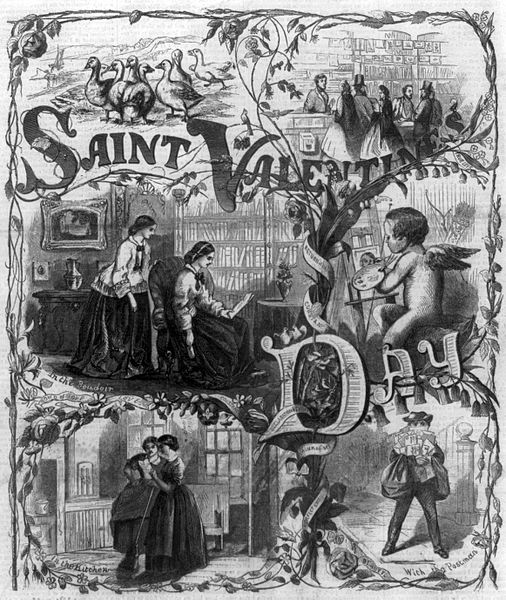Someone you encounter today will tell you Valentine's Day is a made-up holiday pushed by a secret coalition of greeting card companies, candy cabals, and floral cartels trying to boost profits in the post-Christmas slump. Those people are wrong.
 |
| Maybe. The above could only have come from a soulless Faustian fraternity working in concert with the minions of Hell. |
Here are some fun facts about the history of Valentine's Day you can use to put the naysayers in their place, and to dazzle your friends and lovers.
You might know that Valentine's Day originated as a Catholic feast commemorating St. Valentine, but did you know there is more than one St. Valentine honored by the day? Valentine of Terni was a second century bishop martyred during the Roman persecution of Christians. When he was jailed for preaching his faith, he reputedly healed his jailer's daughter of blindness, thus earning a few new converts and a date with clubs, stones, and the executioner's axe. Valentine of Rome hails from the fifth century. He was also persecuted, imprisoned, tortured, and executed. Romance! Legend has it that Mr. Of Rome performed secret marriage ceremonies for Roman soldiers, who were forbidden to marry. His flower-adorned skull is a relic on display in the Basilica of Santa Maria in Cosmedin.
_Skull_of_St._Valentini_._Valentini.JPG/800px-Santa_Maria_in_Cosmedin_(Rome)_Skull_of_St._Valentini_._Valentini.JPG) |
| Your move, Hallmark. |
The feast of St. Valentine was not originally fixed to the fourteenth day of February. Even today, the Eastern Orthodox church honors the Saints Valentine in July, on the sixth for Valentine of Rome, and on the thirtieth for Valentine of Terni.
Valentine's Day was first connected to romantic love by Geoffrey Chaucer in the high middle ages. To commemorate the engagement of King Richard II of England to Anne of Bohemia, he penned "Parlement of Foules," which begins:
For this was on seynt Volantynys day
Whan euery bryd comyth there to chese his make.
Mid-February isn't really sexy time for most species of birds in England, so this poem also provides a clue that Valentine's Day wasn't always observed on 14 February, but sometime later in the spring. Also, we know the engagement was made official in a treaty signed May 2, 1381. Aww, political marriages. Romance!
Over the next many centuries, Valentine's Day really hit its stride. It was a big hit with followers of the courtly love traditions. Valentine love poems and letters dating back to the 1400's have survived to tell the tale. Donne and Shakespeare both wrote about Valentine's Day ( in "An Epithalamion, Or Mariage Song, On The Lady Elizabeth, And Count Palatine Being Married On St. Valentines Day" and Hamlet, respectively).
The giving of flowers and chocolates on Valentine's Day are folk traditions from the UK which commemorate the early advent of spring. In some places, sweets and gifts were left for children, while other communities latched onto it as a celebration of romantic love.
 |
| The ducks are an interesting artistic choice. |
A couple years back, one of my favorite blogs, Two Nerdy History Girls, featured this amazing anti-Valentine's Day screed written in 1805 by an indignant father and published in The Gentleman's Magazine:
My eldest daughter who never receives any letter which she would wish to conceal from her parents, finding that her billet contained what appeared to be Poetry, began to read it to us; but she fortunately had not gone beyond the second line, when I recollected (from having heard of them in my boyish days) what the sequel was; and, snatching, as quick as lightning, the abominable Valentine from her hands before she could possibly arrive at the meaning, threw it upon the fire, congratulating my daughter on having escaped reading the most horrid obscenity that depravity could invent.
This is just an excerpt. I encourage you to read the whole post at Two Nerdy History Girls for the entire, hilarious epistle. The gentleman must have, in his own youth, utilized a publication akin to The Young Man's Valentine Writer, to be so familiar with the "horrid obscenity" his daughter received in the morning post.
 |
| On Life's Sea In Love's Boat Ever with thee I would float The poetry really hasn't gotten any worse, although that's not saying much. |
From Victorian times onward, commercial valentines have been a mainstay of the holiday, making observation of the occasion affordable for everyone, down to the least popular kid in the fourth grade.
I hope you've enjoyed this little overview of the history of Valentine's Day. Whether you're celebrating with a special loved one, children, friends, or a box of chocolates pour un, do so with a clear mind, knowing that by sending flowers and buying cornball greeting cards, you're doing your part to uphold ancient, proud traditions.

Fighting insects in Riyadh Insulation of roofs in Riyadh Detection of water leaks in Riyadh Sewage cleaning company in Riyadh Shipping Company in Riyadh Insect control company in Jizan Water leak detection company in Taif Moving furniture in Taif
ReplyDeleteVery useful article
ReplyDelete-------------
شركة مكافحة حشرات ببريدة
شركة مكافحة حشرات بالدوادمي
شركة مكافحة حشرات بتبوك
شركة مكافحة حشرات بضباء